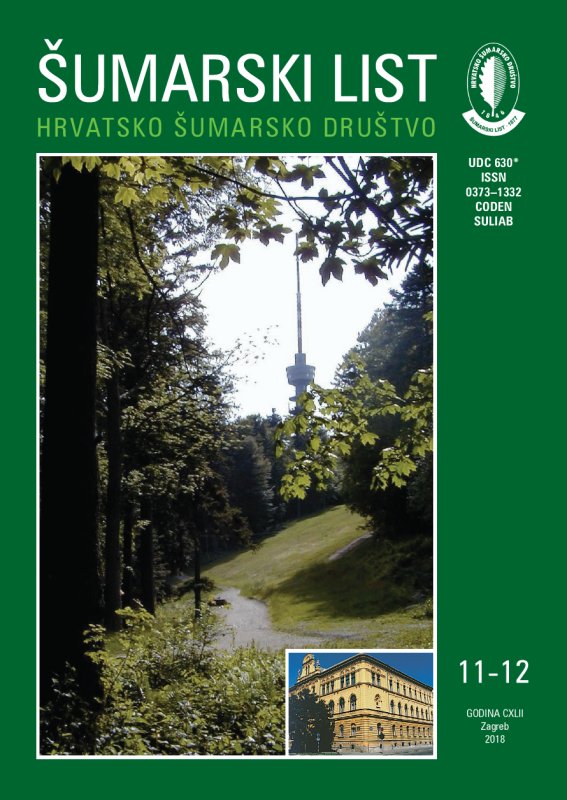
broj: 11-12/2018
pdf (14,99 MB) |
|
||||||||||||||
| RIJEČ UREDNIŠTVA | ||
| Uredništvo | ||
| What percent of the population is aware of the forestry profession? pdf HR EN | 565 | |
| IZVORNI ZNANSTVENI ČLANCI | ||
| Mateo Gašparović, Anita Simic Milas, Ante Seletković, Ivan Balenović | UDK 630* 587 (001) https://doi.org/10.31298/sl.142.11-12.1 | |
| A novel automated method for the improvement of photogrammetric DTM accuracy in forests pdf HR EN | 567 | |
| SUMMARY Accuracy of a Digital Terrain Model (DTM) in a complex forest environment is critical and yet challenging for accurate forest inventory and management, disaster risk analysis, and timber utilization. Reducing elevation errors in photogrammetric DTM (DTMPHM), which present the national standard in many countries worldwide, is critical, especially for forested areas. In this paper, a novel automated method to detect the errors and to improve the accuracy of DTMPHM for the lowland forest has been presented and evaluated. This study was conducted in the lowland pedunculate oak forest (Pokupsko Basin, Croatia). The DTMPHM was created from three-dimensional (3D) vector data collected by aerial stereo-photogrammetry in combination with data collected from existing maps and field surveys. These data still present the national standard for DTM generation in many countries, including Croatia. By combining slope and tangential curvature values of raster DTMPHM, the proposed method developed in open source Grass GIS software automatically detected 91 outliers or 3.2% of the total number of source points within the study area. Comparison with a highly accurate LiDAR DTM confirmed the method efficiency. This was especially evident in two out of three observed subset areas where the root mean square error (RMSE) values decreased for 8% in one and 50% in another area after errors elimination. The method could be of great importance to other similar studies for forested areas in countries where the LiDAR data are not available. Key words: digital terrain model (DTM); vertical accuracy; LiDAR; lowland forest | ||
| Mirzeta Memišević Hodžić, Dalibor Ballian | UDK 630* 451 + 153 (001) https://doi.org/10.31298/sl.142.11-12.2 | |
| Phenological variability of pedunculate oak (Quercus robur L.) in Bosnian-Herzegovinian provenance trial pdf HR EN | 579 | |
| Sezgin Ayan, Nezahat Turfan, Esra Nurten Yer, Muhidin Šeho, Halil Barş Özel, Fulvio Ducci | UDK 630* 453 (001) https://doi.org/10.31298/sl.142.11-12.3 | |
| Antioxidant variability of the seeds in core and marginal populations of taurus cedar (Cedrus libani A. Rich.) pdf HR EN | 593 | |
| Cumhur Güngöroglu, Ç. Okan Güney, Abdullah Sari, Ayhan Serttaş | UDK 630* 537 + 238 (001) https://doi.org/10.31298/sl.142.11-12.4 | |
| Predicting crown fuel biomass of Turkish red pine (Pinus brutia Ten.) for the Mediterranean regions of Turkey pdf HR EN | 601 | |
| Fahrettin Atar, Ibrahim Turna | UDK 630* 923 + 619 (001) https://doi.org/10.31298/sl.142.11-12.5 | |
| Fruit and seedling diversity among sweet chestnut (Castanea sativa Mill.) populations in Turkey pdf HR EN | 611 | |
| PRETHODNO PRIOPĆENJE | ||
| Kristijan Tomljanović, Helena Nosek, Renata Pernar, Marijan Grubešić | UDK 630* 156 + 153 https://doi.org/10.31298/sl.142.11-12.6 | |
| Possibilities of applying lightweight unmanned aerial vehicles to big game counting pdf HR EN | 621 | |


